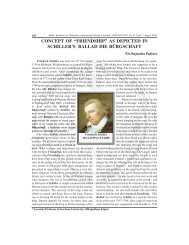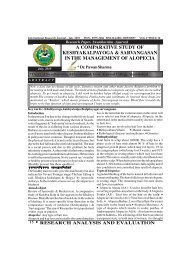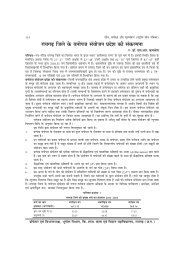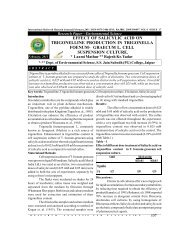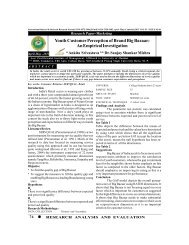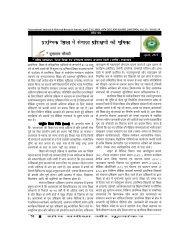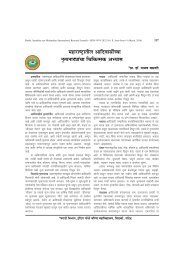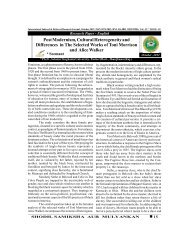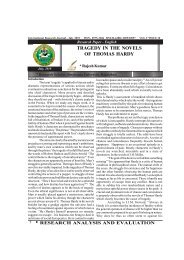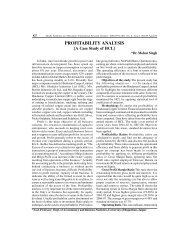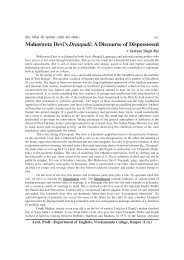Dresses & Ornaments of The Gonds of Madhya Pradesh
Dresses & Ornaments of The Gonds of Madhya Pradesh
Dresses & Ornaments of The Gonds of Madhya Pradesh
Create successful ePaper yourself
Turn your PDF publications into a flip-book with our unique Google optimized e-Paper software.
International Referred Research Journal, July, 2011. ISSN- 0974-2832 RNI-RAJBIL 2009/29954.VoL.III *ISSUE-30<br />
<strong>The</strong> old <strong>Madhya</strong> <strong>Pradesh</strong> (Central Provinces) was well<br />
known as the abode <strong>of</strong> Gond tribes.It was due to the<br />
large number <strong>of</strong> Gond tribes residing in this tract, it was<br />
known as Gondwana. <strong>The</strong>se tribes are known for their<br />
rich socio-culture life. <strong>The</strong> dresses and ornaments <strong>of</strong><br />
the said tribes is a part and parcel <strong>of</strong> the socio-cultural<br />
life <strong>of</strong> Gond tribes. Thus the researcher tries to explore<br />
the new meaning and interpretations <strong>of</strong> their dressing<br />
and ornamentation behaviour.<strong>The</strong> relation <strong>of</strong> the dresses<br />
and ornaments is very much correlated. In Indian context<br />
both <strong>of</strong> these things go hand to hand. As the Indians<br />
attire particular dress or ornaments for particular<br />
purpose. Even the tribes wore the same but with different<br />
need and different purposes. <strong>The</strong> Gondi word for<br />
cloth is dikadi and ornaments are known as Gahna.<br />
<strong>The</strong>re are many references one can refere <strong>of</strong> tribal dressings.<br />
Sir R. Jenkins described the <strong>Gonds</strong> in 1827 AD as<br />
naked savages. Fifty years after that in 1866 AD. , when<br />
Rev. Hislop wrote mainly about Chanda region <strong>of</strong> the<br />
<strong>Madhya</strong> <strong>Pradesh</strong> that the women in the wilder tracts<br />
wear no cloths at all, but only a string round the waists.<br />
<strong>The</strong> practice was reported to exist in the Kol<br />
country, and also in Orissa, where it was traced up to the<br />
command <strong>of</strong> one <strong>of</strong> their deities to reprove women for<br />
their pride. After him Rowney wrote in 1888 AD and said<br />
that; "the manjee and maree <strong>Gonds</strong> lived in a state <strong>of</strong><br />
nature with their bodies covered with ashes and dirt."<br />
<strong>The</strong>re were various other writers who mentioned that<br />
the Hill Marias wear pieces <strong>of</strong> bark as their only dress.<br />
From the above accounts as well as looking at the Hill<br />
Marias <strong>of</strong> Bastar and Chanda, it was clear that they were<br />
all over scantily attired in the early days and their bark<br />
coat, taghali, as Marias called it, showed that the Marias<br />
formerly roamed about in a state <strong>of</strong> nature and then, later<br />
on they adopted leaves and barks as their garments.<br />
However, with the changed times they adopted the<br />
following attire.<strong>The</strong> <strong>Gonds</strong> <strong>of</strong> <strong>Madhya</strong> <strong>Pradesh</strong> wore a<br />
strip <strong>of</strong> cloth was the usual dress <strong>of</strong> the men, but generally<br />
the full toilet comprised a square piece <strong>of</strong> cloth<br />
tied round the head; a cloth gathered round the waist,<br />
and one end brought from the front between the legs<br />
and fastened behind; a cloth thrown loosely over the<br />
shoulder; and a blanket. <strong>The</strong> orthodox Gond custom<br />
was to wear as little as possible. Men seldom wore more<br />
30<br />
Research Paper—History<br />
<strong>Dresses</strong> & <strong>Ornaments</strong> <strong>of</strong> <strong>The</strong> <strong>Gonds</strong> <strong>of</strong><br />
<strong>Madhya</strong> <strong>Pradesh</strong><br />
* Dr. Shamrao I. Koret<br />
July, 2011<br />
* Asstt. Pr<strong>of</strong>, P. G. Dept <strong>of</strong> History, Rashtrasant Tukadoji Maharaj, Nagpur University, Nagpur<br />
that a piece <strong>of</strong> loincloth and a small piece <strong>of</strong> fabric round<br />
their heads. Those who were more civilized threw a<br />
sheet <strong>of</strong> cloth over the upper part <strong>of</strong> the body, in addition<br />
to these. On the east <strong>of</strong> Chanda region, the men<br />
wear no covering for their head or for the upper part <strong>of</strong><br />
their bodies and constantly go about with a battle-axe<br />
in their hands. <strong>The</strong> women were decked themselves<br />
with 30 or 40 strings <strong>of</strong> beads, to which some add a<br />
necklace <strong>of</strong> pendent bells. Bangles <strong>of</strong> zinc adorn their<br />
wrist, and a chain <strong>of</strong> the some metal was suspended from<br />
the hair, and attached to a large boss struck in the ear.<br />
<strong>The</strong> dress <strong>of</strong> the women was always decent, and consisted<br />
<strong>of</strong> one long piece <strong>of</strong> cloth about eighteen feet<br />
long and three and half broad. That was doubled and<br />
fastened round the waist. <strong>The</strong> lower half hangs to the<br />
knees, and the front end was brought between the legs,<br />
and secured behind, while the upper half was carried<br />
over the right shoulder.<br />
<strong>The</strong> women wore lungra (saree) which passes<br />
like a broad sash over the back and was rather liberally<br />
spread out in front upon their bosom, <strong>The</strong> <strong>Gonds</strong> <strong>of</strong><br />
Mandla were extremely simple in their clothing, the men<br />
usually wear a pheta or a small piece <strong>of</strong> cloth to cover<br />
the head and a dhoti about four feet long and a foot and<br />
half broad, round their waist. Those who could not<br />
even afford this, were content with a langoti (a scanty<br />
scrap) won as loin-cloth, Those who could afford, wear<br />
bandee, or waistcoat and shirt but they wear them on<br />
special occasions only, these did not form a part <strong>of</strong> their<br />
daily wardrobe; women wear a saree or lungra as they<br />
called it but it was just like a loin-cloth with the red<br />
border dragged up over their knees exposing the greater<br />
part <strong>of</strong> the thigh. <strong>The</strong> Hill Maria <strong>of</strong> Bastar wore nothing<br />
but a lion cloth <strong>of</strong> coarse cotton in winter, summer and<br />
during rains. <strong>The</strong> Dhurwa <strong>of</strong> Bastar remained bare-bodied<br />
for most <strong>of</strong> the year. <strong>The</strong> Marias wore no cloth on<br />
their head but it seemed that some <strong>of</strong> them were learning<br />
the habit <strong>of</strong> wearing an apology for a pagree or turban,<br />
by wrapping a small rag carelessly round the head leaving<br />
the crown generally bare.<strong>The</strong> Maria women go about<br />
with their breast uncovered. <strong>The</strong>y had only a lion cloth<br />
wrapped round waist with pr<strong>of</strong>usion <strong>of</strong> ornaments<br />
around the neck and countries strings <strong>of</strong> beads. Very<br />
old women inside the hut wear only a square piece <strong>of</strong>
International Referred Research Journal,July, 2011. ISSN- 0974-2832 RNI-RAJBIL 2009/29954.VoL.III *ISSUE-30<br />
cloth suspended between the legs from a waist cord as lavish in getting their face, foreheads, arms and <strong>of</strong>ten<br />
their sole covering. This underwear was known as breasts elaborately tattooed. <strong>The</strong>re was some magicoreligious<br />
sanctity attached to tattooing. <strong>The</strong> women<br />
mundang and was worn only by the females. However,<br />
with the changed time they changed their attire. believed that tattooing beautifies the body as well as<br />
<strong>Ornaments</strong>: - As ornaments, Gond men wore tin or silver makes it healthy.<strong>The</strong>re were different traditional patterns<br />
for the arms, chest, forehead and brow and it was<br />
bracelets, one on each wrist, called chura. On the third<br />
or little finger <strong>of</strong> either hand they sometimes wear a ring compulsory to tattoo only the correct pattern on each<br />
<strong>of</strong> silver or brass. It was called mundri. In their ears, they part <strong>of</strong> the body. It was believed that when they died<br />
wear rings, i.e. bari, in the upper part <strong>of</strong> the ear; the bala, would able to show some beauty on their bodies to<br />
piercing the middle ear; and the lurki, through the lobe. Bhagwan (God). Another motive for tattooing was social<br />
ambition, and third cause appeared that girl's par-<br />
<strong>The</strong>y adorned their heads with small brass coins and<br />
glass beads. Many Gond women wear a necklace <strong>of</strong> ents must be wealthy or must have loved their daughter<br />
rupee or eight-anna pieces, linked into a chain by thin very much.<br />
silver chains, or simply by a string through a loop Observation: - It is observed by the researcher that the<br />
attached to each coin. <strong>The</strong> necklace <strong>of</strong> rupees was dress pattern <strong>of</strong> the tribes changed with the time. <strong>The</strong><br />
called rupeeya or bawal. <strong>The</strong>y also wear the hasli, a dress pattern was very much natural, which could be<br />
silver nickering in the shape <strong>of</strong> a snake, with one end obtainable from the surrounding jungle. It is to be noted<br />
hooked into other at the back <strong>of</strong> the neck. Another neckring<br />
was the so-called sutiya or suta, a neck let about as not a cotton growing area. It shows that the cloth was<br />
that the geographical area meant for their dwelling was<br />
thick as a finger, made <strong>of</strong> silver. <strong>The</strong> Gond women had a rare article for the secluded tribes living in isolation<br />
their ears pierced at various places. <strong>The</strong> common ear since time immemorial. Scarcity <strong>of</strong> cloth made them to<br />
ornament was called Kiwli. Gond women <strong>of</strong>ten wear in use more metal ornaments on their body and less dressing.<br />
Otherwise wearing less was not a custom or culture<br />
the nose a small flower-like stud which was called as<br />
phuli. On the wrists, they wear bangles (churi) or silver <strong>of</strong> the Gond tribes. However with the changed time and<br />
bracelet (gujri); at the elbow the bahota. <strong>The</strong>ir toes were availability <strong>of</strong> the article, these tribes adopted the newer<br />
decorated with one or two brass rings, usually one on pattern <strong>of</strong> the dressing. On the other hand the ornaments<br />
used by the tribes, were not meant for aesthetic<br />
the big toe (chutka) and one on the third toe (chutki).<br />
<strong>The</strong>se rings were <strong>of</strong> silver or any metal. Sometimes the purposes, but they wore them for various purposes.<br />
women wear toe ornaments with a high projecting knob Many <strong>of</strong> the above mentioned ornaments protect them<br />
on three toes, they were called as bichya.<br />
from the surrounding inhabitants. Like the snakes will<br />
Tattooing: - <strong>The</strong> men wore only a few tattoo mark on the go away with the vibrating anklets sound at their feet.<br />
outer side <strong>of</strong> their legs, at knee-level and sometimes on <strong>The</strong> animals could not harm their body as many<br />
the upper arms. However, the Gond women were conspicuous<br />
for their tattooing over a large part <strong>of</strong> the body. not an ordinary one; instead it had some medicinal<br />
rings, headgears covered them. <strong>The</strong> mask <strong>of</strong> the dirt was<br />
Gond women preferred stars, crosses, and crude figures values which keep them protected from all kinds <strong>of</strong> the<br />
<strong>of</strong> men and animals as tattoo marks. A Gond girl was first jungle flies and insects. <strong>The</strong> tattooing on their body was<br />
tattooed when she was only a few years old: on the also very much important, which keep them unnoticed<br />
forehead and temples, and on the right cheek. On the during games. Even the women remain safe from the<br />
forehead just above the nose the figure <strong>of</strong> the hearth in eyes <strong>of</strong> any intruder. <strong>The</strong>se dressing patterns and <strong>Ornaments</strong><br />
were later well supported with religious values<br />
horse-shoe form, with the open side pointing downwards,<br />
with a dot on each side and one below. When to be accepted by the common masses. Otherwise one<br />
a girl reached puberty, she was tattooed on the arms, could not find special dress for special purpose among<br />
chest and shoulders. Later, just before or after marriage, tribes. In certain times like dance and other ceremonies<br />
she might also be tattooed on the back <strong>of</strong> her legs, from only the participant need to wear particular dresses and<br />
the knees to the ankles, and on the thighs. Tattooing ornaments to display the models for others to follow.<br />
was very common among the <strong>Gonds</strong>. Women were more <strong>The</strong>refore, it is concluded that the tribal dresses and<br />
R E F E R E N C E<br />
ornaments were protective gadgets.<br />
Hislop, Papers relating to the Aboriginal tribes <strong>of</strong> the central Provinces, (Nagpur: 1866), p. 8. Quoted in, M.J. Walhouse, some Account <strong>of</strong> a leaf-wearing<br />
tribe on the Western coast <strong>of</strong> India, in the Journal <strong>of</strong> the Anthropological Institute <strong>of</strong> Great Britain and Ireland, Vol.4 (1875), p. 376. H.B. Rowney, <strong>The</strong> Wild<br />
tribes <strong>of</strong> India, (Delhi:1882), p.7. Indrajit Singh, op. cit., p. 22. A.C.Lyall, (Sir) , Reports <strong>of</strong> the ethnological committee on papers laid before them, and,<br />
examination <strong>of</strong> specimens <strong>of</strong> aboriginal tribes brought to Jabalpur exhibition <strong>of</strong> 1866-67, Nagpur, 1867, pp. 21-2. Indrajit Singh, <strong>The</strong> Gondwana and the<br />
<strong>Gonds</strong>, <strong>The</strong> Universal Publishers, Lucknow, 1944, p. 22. Captain Ward, Report on LRS <strong>of</strong> Mandla District, 1868-9, p. 132. A.C.Lyall, op. cit., p. 21-2.<br />
Hislop, Papers, Appencix VII, p. xiii. Stephen Fuchs, Gond and Bhumia <strong>of</strong> Eastern Mandla, Asia Pub. House, New Delhi, 1960, p. 53. Indrajit Singh, op.<br />
cit., p. 23. Kidar Nath Thusu, Gond Kingdom <strong>of</strong> Chanda, A.S.I. Calcutta, 1980, p .38. Captain Ward, Report on LRS <strong>of</strong> Mandla District, 1868-9, pp. 135-<br />
6. Kidar Nath Thusu, op. cit., p. 40. Stephen Fuchs, op. cit., p. 61. Ibid. Suresh Mishra, <strong>The</strong> Gond Kingdom <strong>of</strong> Garha, (New Delhi: 2007), p.18. Stephen<br />
Fuchs, op. cit., p. 62.<br />
S H O D H S A M I K S H A A U R M U L Y A N K A N 31



